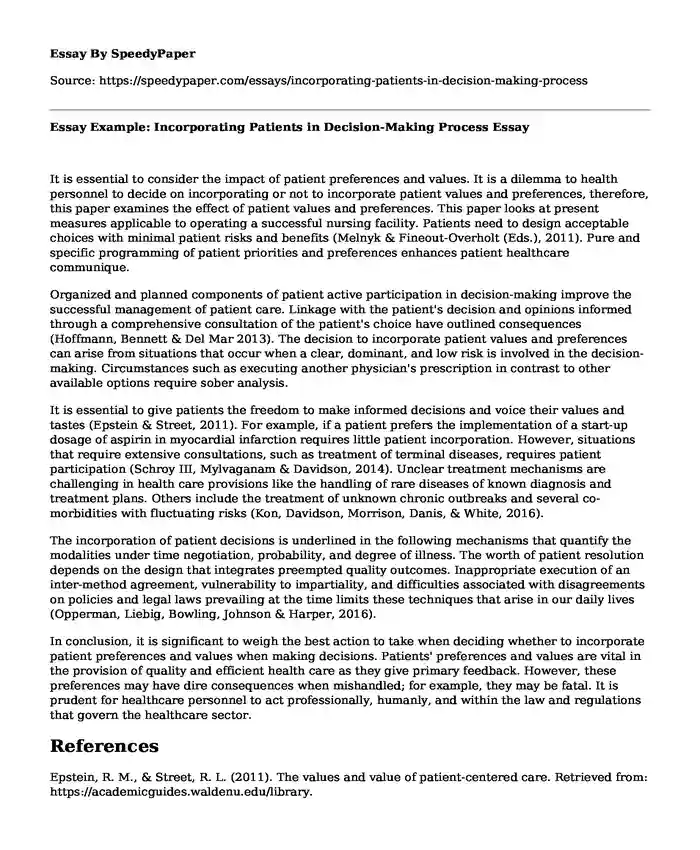
| Type of paper: | Research paper |
| Categories: | Nursing Healthcare policy Community health |
| Pages: | 3 |
| Wordcount: | 616 words |
It is essential to consider the impact of patient preferences and values. It is a dilemma to health personnel to decide on incorporating or not to incorporate patient values and preferences, therefore, this paper examines the effect of patient values and preferences. This paper looks at present measures applicable to operating a successful nursing facility. Patients need to design acceptable choices with minimal patient risks and benefits (Melnyk & Fineout-Overholt (Eds.), 2011). Pure and specific programming of patient priorities and preferences enhances patient healthcare communique.
Organized and planned components of patient active participation in decision-making improve the successful management of patient care. Linkage with the patient's decision and opinions informed through a comprehensive consultation of the patient's choice have outlined consequences (Hoffmann, Bennett & Del Mar 2013). The decision to incorporate patient values and preferences can arise from situations that occur when a clear, dominant, and low risk is involved in the decision-making. Circumstances such as executing another physician's prescription in contrast to other available options require sober analysis.
It is essential to give patients the freedom to make informed decisions and voice their values and tastes (Epstein & Street, 2011). For example, if a patient prefers the implementation of a start-up dosage of aspirin in myocardial infarction requires little patient incorporation. However, situations that require extensive consultations, such as treatment of terminal diseases, requires patient participation (Schroy III, Mylvaganam & Davidson, 2014). Unclear treatment mechanisms are challenging in health care provisions like the handling of rare diseases of known diagnosis and treatment plans. Others include the treatment of unknown chronic outbreaks and several co-morbidities with fluctuating risks (Kon, Davidson, Morrison, Danis, & White, 2016).
The incorporation of patient decisions is underlined in the following mechanisms that quantify the modalities under time negotiation, probability, and degree of illness. The worth of patient resolution depends on the design that integrates preempted quality outcomes. Inappropriate execution of an inter-method agreement, vulnerability to impartiality, and difficulties associated with disagreements on policies and legal laws prevailing at the time limits these techniques that arise in our daily lives (Opperman, Liebig, Bowling, Johnson & Harper, 2016).
In conclusion, it is significant to weigh the best action to take when deciding whether to incorporate patient preferences and values when making decisions. Patients' preferences and values are vital in the provision of quality and efficient health care as they give primary feedback. However, these preferences may have dire consequences when mishandled; for example, they may be fatal. It is prudent for healthcare personnel to act professionally, humanly, and within the law and regulations that govern the healthcare sector.
References
Epstein, R. M., & Street, R. L. (2011). The values and value of patient-centered care. Retrieved from: https://academicguides.waldenu.edu/library.
Hoffmann, T., Bennett, S., & Del Mar, C. (2013). Evidence-based practice across the health professions-e-Book. Elsevier Health Sciences. Retrieved from: https://academicguides.waldenu.edu/library.
Kon, A. A., Davidson, J. E., Morrison, W., Danis, M., & White, D. B. (2016). Shared decision-making in intensive care units. Executive summary of the American College of Critical Care Medicine and American Thoracic Society policy statement. Retrieved from: https://academicguides.waldenu.edu/library.
Melnyk, B. M., & Fineout-Overholt, E. (Eds.). (2011). Evidence-based practice in nursing & healthcare: A guide to best practice. Lippincott Williams & Wilkins. Retrieved from: https://academicguides.waldenu.edu/library.
Opperman, C., Liebig, D., Bowling, J., Johnson, C. S., & Harper, M. (2016). Measuring return on investment for professional development activities: Implications for practice. Journal for nurses in professional development, 32(4), 176-184. Retrieved from: https://academicguides.waldenu.edu/library.
Schroy III, P. C., Mylvaganam, S., & Davidson, P. (2014). Provider perspectives on the utility of a colorectal cancer screening decision aid for facilitating shared decision making. Health Expectations, 17(1), 27-35. Retrieved from: https://academicguides.waldenu.edu/library
Cite this page
Essay Example: Incorporating Patients in Decision-Making Process. (2023, Feb 23). Retrieved from https://speedypaper.net/essays/incorporating-patients-in-decision-making-process
Request Removal
If you are the original author of this essay and no longer wish to have it published on the SpeedyPaper website, please click below to request its removal:
Popular categories




